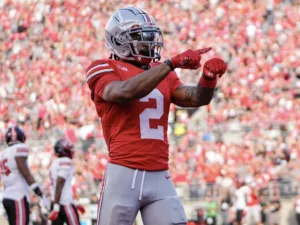
Can College Yards After Catch Help Predict NFL Success For Wide Receivers?
For our 61 part “Does It Matter?” series, we looked into whether a Wide Receiver’s College Yards After Catch per Reception (YAC/Rec)
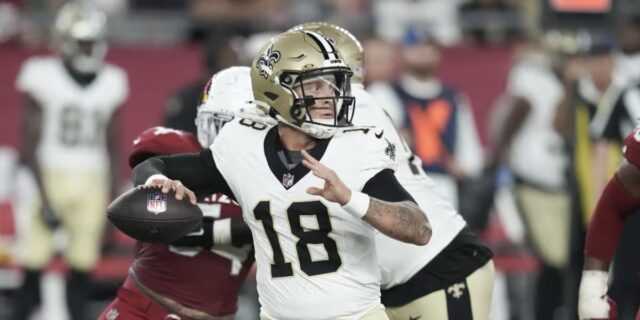
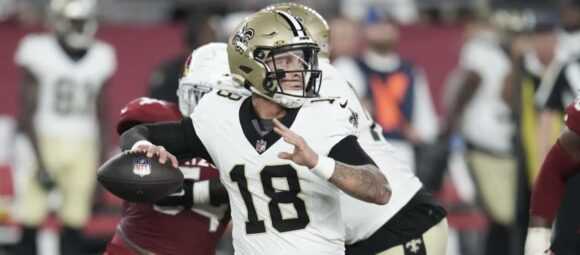
For part 19 of our “Does It Matter?” series, we explored whether Body Mass Index (BMI) can predict NFL quarterback success. To understand this, we looked at the top 30 fantasy football finishers since 2003. In this article, you will see the optimal BMI threshold for QB’s and bare minimum critical values you should hope for in your favorite QB prospects.
We analyzed the top 50 fantasy football finishers for each season since 2003. Further, we used strictly NFL draft combine weight and height measurements for consistency. In our data, we excluded rookie seasons to not factor in rookie struggles often seen by NFL QB’s. Throughout this study, you will see the term “bottom 5,” which is defined as those finishing between 26th and 30th place.
First, we wanted to craft an averages chart where we can see the average BMI of different thresholds in our data. By comparing these groups, we could possibly identify patterns in QB BMI’s and whether higher or lower BMI’s typically correspond to higher success. Specifically, we categorized these averages into four groups:
The chart revealed that the average BMI of top 5 finishers was higher than the average BMI of the 21st – 30th place finishers in 17 out of 21 years, which equates to 81%.
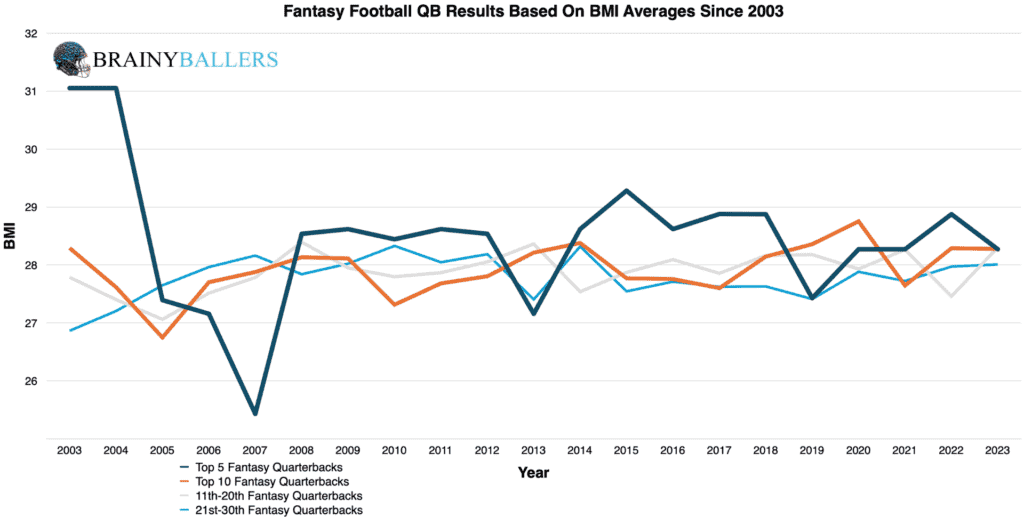
To look further into BMI’s, we segmented the top and bottom 5 finishers’ BMI since 2003 into 0.1 BMI increments. This segmentation would hopefully allow us to observe trends more clearly by comparing the charts to each other. From this, we seen an interesting pattern: as BMI increased, the consistency of top 5 finishes also increased. Therefore, the trend is starting to become more apparent that higher BMI quarterbacks were more likely to produce top 5 fantasy seasons, and consistently, than bottom 5. Those charts can be seen below, with the top 5 first:
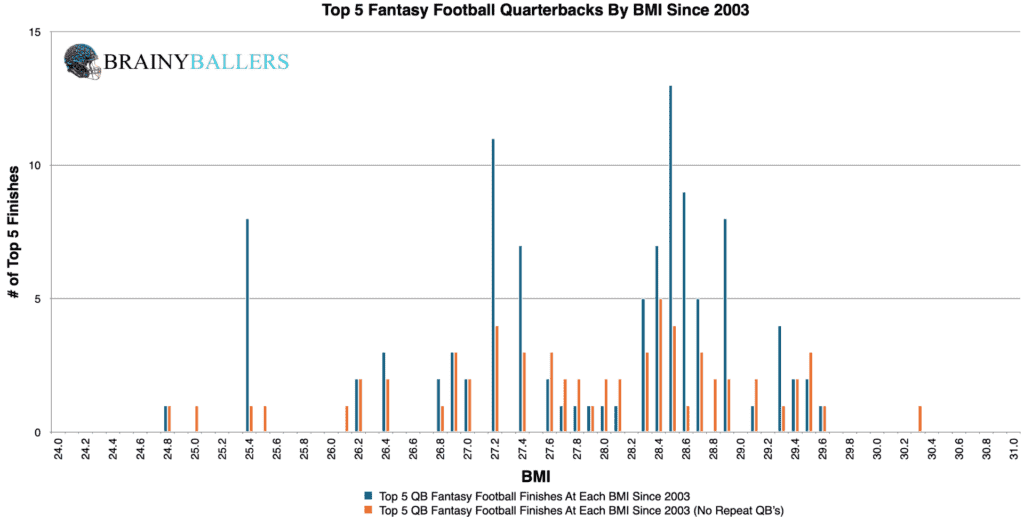
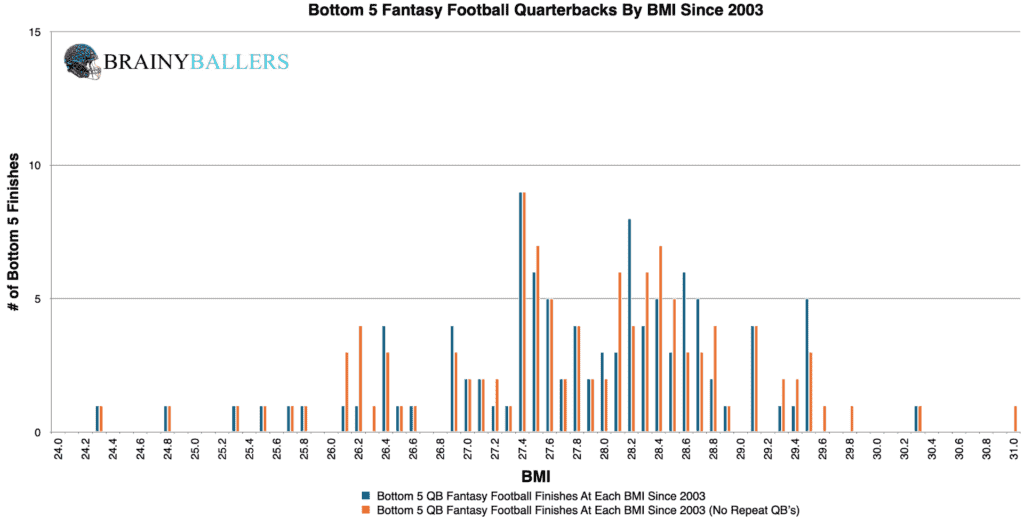
In hopes of finding an optimal BMI range, or threshold, we created a differences chart which compares each BMI to the next 1.0, subtracting the bottom 5 results from the top 5. This should also make it evident where fewer unique players appear, showcasing top-level consistency. The chart’s desired outcome is a negative number for unique differences (Orange) and a positive number for non-unique differences (Blue). This would indicate the desired consistent top level performances we are hoping for. From this, it appears that the BMI range from 27.9 to 30.3 is a potential optimal BMI range. Next, we will attempt to verify this as the optimal range.
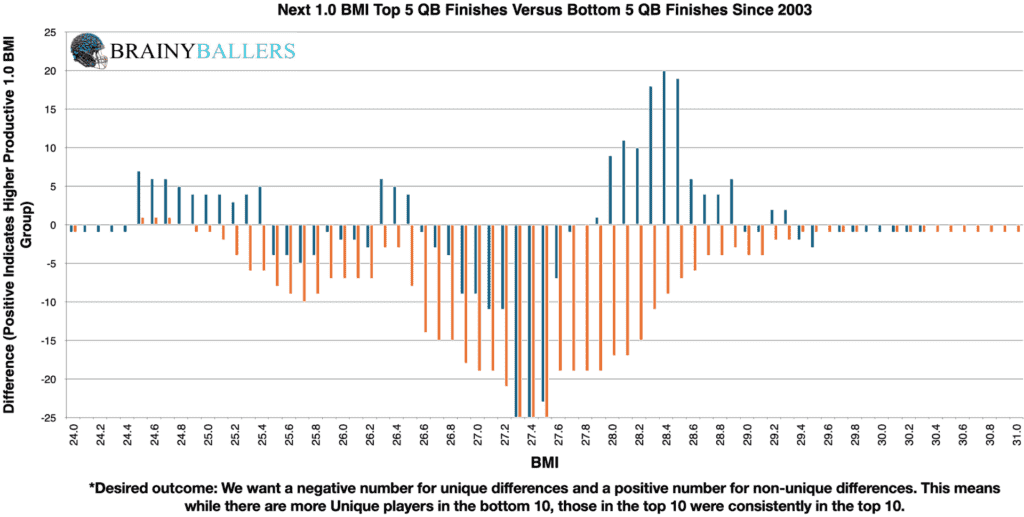
Next, we went deeper by comparing this BMI range to all QBs who finished in the bottom 5 since 2003. Out of 105 quarterbacks, 54 were within the BMI range of 27.9 to 30.3, accounting for 51.4%. This percentage served as a baseline to evaluate whether this was an average BMI for all QBs, or top-performing QBs specifically, which we will look at next.
To determine if the BMI range of 27.9 to 30.3 was indicative of top-performing QBs, we analyzed the top 5 finishers from 2003 to 2023. If a higher percentage than 51.4% (as seen in the bottom 5) occurs in the top 5, then we found a top performing QB BMI specifically. Among 105 top 5 finishers, 60 were within this BMI range, which accounts for 57.1%. This is a 5.7% increase compared to the bottom 5 finishers, suggesting that higher performance was more common when within this BMI range. Although this is good, we wanted to verify this is the highest performing range by testing ranges close to this, which we will do next.
To determine whether this is indeed the top producing QB BMI range, we played with the bottom and top end of this range to see what produces the largest top 5 to bottom 5 percentage increase. By doing this, we found that setting the threshold at 28.3 and above resulted in a 19.0% higher occurrence in the top 5 than the bottom 5. This new range — 28.3 BMI and above — emerged as the more optimal threshold and will be the subject of this research going forward.
Due to these findings, BMI could play a factor in our Star-Predictor Score (SPS) model. Since 24.8 BMI is the lowest seen since 2003 in the top 5, that will be our critical value for the SPS. The Star-Predictor Score (SPS) is a scouting tool designed to maximize investment potential and reduce risks when drafting rookies in Fantasy Football. It is proven to have a higher accuracy than draft capital alone to predict fantasy success. The SPS includes 13 to 17 metrics, with the exact number varying by the player’s position. All these metrics are pre-NFL, and some are invented by us, providing a complete analysis of a player’s analytical profiles. The SPS gained widespread notoriety for its high accuracy, having made it on Barstool and The Pat McAfee Show. The SPS can be found here.

We next wanted to employ standard statistical methods to find correlation between BMI and fantasy production. In doing so, we found some less than flattering metrics:
This indicates no strong correlation between Body Mass Indexes and fantasy production. We are hoping for a minimum of 0.1, or an inverse correlation maximum of -0.1 when we study world-class athletes as we are. For reference to something that everyone acknowledges matters in prospect scouting, and to show the accompanying Pearson value, RB draft capital prevailed a -0.234 Pearson value.
Despite the lack of regression testing support, we wanted to see if this is a recent trend, or a dying one. Therefore, we looked at the last two decades, split between 2013 and 2014. From this, it was extremely clear that this is a heavily emerging trend. From the earlier decade to the most recent one, there is an astonishing 40% increase in the top 5 performances when compared to the bottom 5.
| 2004-2013 | |||
| Top 5 | 6th-25th | Bottom 5 | |
| All count | 50 | 200 | 50 |
| 28.3 and above | 18 | 88 | 24 |
| % (hard zone/all) | 36.0% | 44.0% | 48.0% |
| 2014-2023 | |||
| Top 5 | 6th-25th | Bottom 5 | |
| All count | 50 | 200 | 50 |
| 28.3 and above | 33 | 86 | 19 |
| % (hard zone/all) | 66.0% | 43.0% | 38.0% |
What 3 metrics matter the most when scouting a rookie Quarterback? What threshold should Quarterbacks achieve within those metrics to be considered an elite prospect? How much should you value those stats above all other stats? Couldn't answer those questions? Rest easy, we have it handled for you. That's what this chart answers. Sort by importance and/or filter by position. Unlock by signing up with the links provided. $9.99/Year or $24.99 Lifetime access. Cancel anytime.
Our identified BMI threshold of 28.3 and above signifies an increased quarterback performance likelihood. This range occurred mostly in the most recent decade by a wide margin. Our findings also established a critical 24.8 BMI threshold for QBs, forming an essential BMI for our StarPredictor Score (SPS) model. Although, it is important to remember that the regression testing prevailed no correlation. Therefore, these results can be taken with a grain of salt.
Our series has always sought to push the boundaries of sports analytics. This latest installment reaffirms our commitment to uncovering the hidden dynamics that define the game. Every Saturday, we’ll dive into intriguing questions, bust myths, and settle debates with thorough analysis. We welcome your input. Therefore, please leave comments or reach out with topics you’re eager to see dissected. Premium Analytics subscribers get priority. All of our research can be found on our Analytics Page. Up next on our agenda for Part 20 of “Does It Matter?” is an examination of the common WR 525 rookie yardage threshold theory: Does it matter? If so, what’s the likelihood a WR will be a success if they reach this threshold? Mark your calendars; every Saturday we shed light on the topics that matter to you. If you’re a Premium Analytics subscriber, all it takes is a quick question being asked and we will go to work for you!



For our 61 part “Does It Matter?” series, we looked into whether a Wide Receiver’s College Yards After Catch per Reception (YAC/Rec)

In part 60 of our “Does It Matter?” series, we dove into the question of whether a college Wide Receiver’s career Average

The “Does It Matter?” series, part 59 looked to uncover the role of a quarterback’s rookie touchdown per game (TD/G) in predicting
© 2023 BrainyBallers | All Rights Reserved